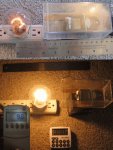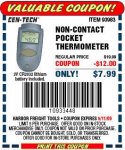Good questions, 691175002, so I took quite a bit of time with the reply...
691175002 said:
...rather skeptical of the magic 3.13
I doubt it is exactly 3.13, but that is the best number I have at the moment, and I believe it will give the 15% accuracy stated. Someone with an accurate LPM will, I hope, double check this. If it turns out that I am off by a few percent and the real magic number is, say, 3.3, then I will edit the first post to include the more accurate number. I had anticipated doing that, and it is one of the reasons I think the initial 15% accuracy statement can be tightened up.
... how did you come up with it anyways considering you don't have a real LPM?
As I mentioned earlier, I used some simple physics to come up with the number. It may be worth detailing my method in a separate thread if anyone is interested, but basically it involves using a thermal conductor with an accurately known heat capacity and reflectivity. By measuring the thermal time constant when laser power is applied, the actual amount of power can be derived. An interesting feature of this is that the thermal resistance doesn't affect the final result (unlike the LPM of this thread).
As a sanity check, I've tested the SLD1239JL-54 laser, and the diodes from some LPC-815 and PHR-803T sleds. Their power vs current curves line up nicely with what has been reported on LPF, but that only gives me ballpark numbers, of course.
The heat dissipation of the black target will vary with its mass/size/thickness/material/shape.
Generally, the thermal resistance (heat dissipation) of a vertical, thermally conductive surface such as aluminum, will vary most strongly with its surface area, while other variables are much less critical.
The mass and thickness (within limits) does not affect steady state dissipation, although it does affect thermal time constant. As I mentioned in the construction section,
"The thickness of the aluminum is not too critical. It's the surface area that is critical. The foil I used is the standard household variety... I have also tested the aluminum from the side of a soft drink can, which was 6 times thicker. It gives the same readings but takes longer to heat up due to its larger thermal mass."
The material specified is aluminum. Certainly if someone decided to use plastic wrap for the target instead, the results would be different.
The shape is either round or square, and the sizes were adjusted to make the two read the same.
Not only that, but the ambient room temperature (which will in turn affect convection) and any drafts will have a huge impact on the readings.
Ambient temperature within a normal range doesn't measurably affect the readings. If you want to learn more about this topic, you can research how convection heat sinks work.
Strong drafts
will affect the readings, and for greatest accuracy in the presence of drafts, it is recommended that the meter be shielded from them by putting it in a box such as the one pictured in the construction section. In an area where there are no fans going, no open windows, no doors being swung, no people running past, you will get the same results whether you enclose the meter or not. Note that drafts also affect many high end LPMs.
You have addressed this somewhat by specifying dimensions but I doubt that will be accurate enough.
The accuracy of the dimensions is very important. That is why I showed a picture of a digital micrometer measuring the square target, and I suggested the round target be cut with a specific piece of tubing which is manufactured to rather high tolerances (the different sizes of tubing sold actually nest together with a sliding fit).
For example, if the square target is .510" by .510" instead of exactly a half inch square, this will throw the readings off a little bit. Doing the math,
(.510 * .510) / (.5 * .5) = 1.040
we see that the surface area is off by 4%, and the readings will be thrown off by roughly the same amount. While 4% error here would be unfortunate, I think you will agree this is still a better method of measuring your laser's power than seeing whether it will light matches! And the price is hard to beat. This gets into the question: "How accurate is accurate enough."
My feeling is that most people can get much closer than .510" if they are careful and give it a couple of tries.
For perfectionists, I would recommend the tubing cutter method. Note that, once you are set up with that, you can stamp these targets out both quickly and accurately. Maybe someone would want to go into production and mail them out to folks for a nominal fee. As an exercise, calculate the material cost per target given that about $6 buys you a roll of aluminum foil (75 square feet!) and a can of paint...
For example, what happens if you move the piece of aluminum foil closer to or against the thermometer?
Good question. I was going to run that experiment, but I thought I would provide my results-so-far when I saw that the IR Thermometer went on sale. Would have been a shame to miss it.
There isn't any reason I know of to think that distance is especially critical, but if it is much farther the IR Thermometer starts to be able to see around the target (so it will average the ambient into the readings). Much closer and the air flow around the target (thus the thermal resistance, which is critical) will be affected. So it's best to keep the target about 1/16" away until someone runs the test (volunteers?).
I think a real test you can do already is get someone else to make one
It looks like that will happen...
or make a few yourself and see how repeatable measurements are across every thermometer.
I actually did quiet a lot of testing on this. The answer is: incredibly repeatable.
Unfortunately, my gut feeling tells me that when different people build these using different materials and to different tolerances you are going to end up with some pretty major variations.
Based on my tests, if it is done carefully and per the instructions, I think people will be within the 15%. Of course, many would call that a pretty major variation. As I said at the beginning,
"... this meter isn't in the same league as more expensive LPM's (which are more accurate and easier to use)..." But it does cost less, and it is quite useful.
lasersbee and jamilm9, thanks for the rep points!





